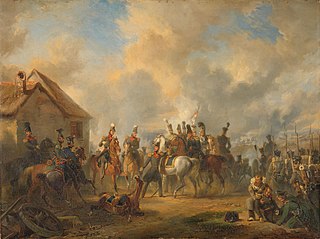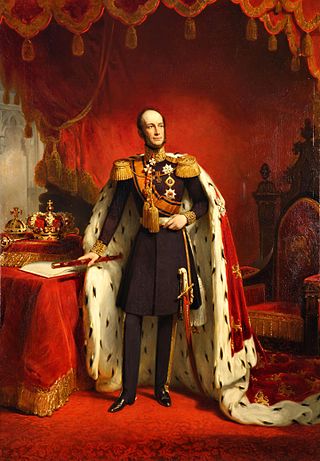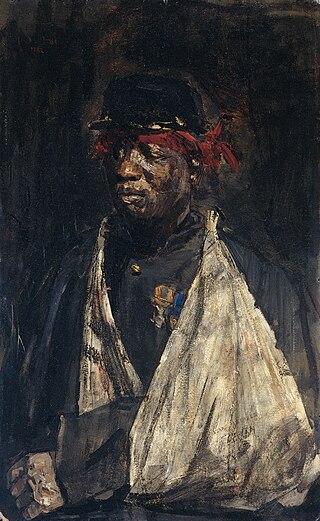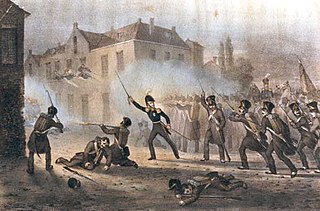
The Rijksmuseum is the national museum of the Netherlands dedicated to Dutch arts and history and is located in Amsterdam. The museum is located at the Museum Square in the borough of Amsterdam South, close to the Van Gogh Museum, the Stedelijk Museum Amsterdam, and the Concertgebouw.

The 1830s was a decade of the Gregorian calendar that began on January 1, 1830, and ended on December 31, 1839.
The Battle of Turnhout, named after the city of Turnhout in northern Belgium, may refer to:

Houthalen-Helchteren is a municipality located in the Belgian province of Limburg. Houthalen-Helchteren consists of Houthalen-centrum, Houthalen-Oost, Helchteren, Sonnis, Laak, Meulenberg and Lillo. On 1 January 2020 Houthalen-Helchteren had a total population of around 30.000. The total area is 78.27 km² which gives a population density of 389 inhabitants per km².
The French Revolutionary Wars began on 20 April 1792 when the French Legislative Assembly declared war on Austria. This launched the War of the First Coalition.

The Belgian Revolution was the conflict which led to the secession of the southern provinces from the United Kingdom of the Netherlands and the establishment of an independent Kingdom of Belgium.

The ten days' campaign was a failed military expedition by the United Kingdom of the Netherlands against the secessionist Kingdom of Belgium between 2 and 12 August 1831. The campaign was an attempt by the Dutch King William I to halt the course of the Belgian Revolution which had broken out in August 1830.

Prince Frederick of the Netherlands, Prince of Orange-Nassau, was the second son of William I of the Netherlands and his wife, Wilhelmine of Prussia.

The Low Countries theatre of the War of the First Coalition, also known as the Flanders campaign, was a series of campaigns in the Low Countries conducted from 20 April 1792 to 7 June 1795 during the first years of the War of the First Coalition. As the French Revolution radicalised, the revolutionary National Convention and its predecessors broke the Catholic Church's power (1790), abolished the monarchy (1792) and even executed the deposed king Louis XVI of France (1793), vying to spread the Revolution beyond the new French Republic's borders, by violent means if necessary. The First Coalition, an alliance of reactionary states representing the Ancien Régime in Central and Western Europe – Habsburg Austria, Prussia, Great Britain, the Dutch Republic, Hanover and Hesse-Kassel – mobilised military forces along all the French frontiers, threatening to invade Revolutionary France and violently restore the monarchy. The subsequent combat operations along the French borders with the Low Countries and Germany became the primary theatre of the War of the First Coalition until March 1796, when Napoleon took over French command on the Italian front.

The siege of Antwerp took place after fighting in the Belgian Revolution ended. On 15 November 1832, the French Armée du Nord under Marshal Gérard began to lay siege to the Dutch troops there under David Chassé. The siege ended on 23 December 1832. The French had agreed with the Belgian rebels that the latter would not participate in the battle.

The Battle of Leuven or Battle of Boutersem was a battle of the Ten Days' Campaign during the Belgian Revolution. The battle took place on 12 August and officially ended on 13 August 1831. The Dutch army defeated the Belgian rebels, but were forced to withdraw in order to avoid war with France, as a large French army under Maréchal Gérard had crossed the border to support the Belgian rebels. They concluded a truce with the Belgians, allowing them to take the city for a few hours on 13 August.

The Battle of Hasselt was fought on 8 August 1831 during the Ten Days' Campaign. It was an important defeat for the outnumbered Belgian Army of the Meuse and a victory for the Dutch invasion force.

William II was King of the Netherlands, Grand Duke of Luxembourg, and Duke of Limburg.

In 1833, following the end of the Belgian Revolution, the young kingdom of Belgium created the Iron Cross to recognise wounds received and bravery in battle. The award first class was bestowed to the wounded who elected to stay at their post and keep fighting, to the maimed and mutilated, as well as for acts of courage, the award second class was bestowed to all wounded combatants. In 1835, due to the discontent of most recipients, the award 2nd class was terminated and all received the first class. Over the years, recipients of the Iron Cross received ever increasing pensions, up to ten years of seniority when employed as civil servants and pensions for the widows and orphans of the deceased. The other combatants of 1830-1831 received no pension, and no commemorative medal was struck.

Portrait of a Wounded KNIL Soldier is an Amsterdam impressionist portrait painting by Isaac Israëls, signed and dated to 1882. It has been in the Rijksmuseum since 2000.

Amber Tysiak is a Belgian professional footballer who plays as a defender for Women's Super League club West Ham United and the Belgium national team.

The Battle of Ravels was a skirmish during the Ten Days' Campaign at the end of the Belgian Revolution. This battle took place on 3 August 1831.

Lambert Nypels was a Belgian military officer. He served in the Grande Armée and took part in numerous battles during the Napoleonic wars. At the end of the Empire, he joined the Dutch Armed Forces and, in 1830, when Belgium gained independence, he sided with Belgium. He then led the Belgian troops until his retirement in 1842.

The Prince of Orange at Quatre Bras is an 1818 battle painting by the Dutch artist Jan Willem Pieneman. It depicts a scene from the Battle of Quatre Bras fought on 16 June 1815, two days before the decisive Battle of Waterloo. The young William, Prince of Orange, heir to the Dutch throne and a Lieutenant General in the British Army, had command of a corps of Allied troops. The Waterloo campaign took place in Belgium which had recently granted to the new United Kingdom of the Netherlands by the Congress of Vienna. William of Orange was the senior Dutch figure present at the battle, serving under the overall command of the Duke of Wellington.

The Battle of Waterloo is a large history painting by the Dutch artist Jan Willem Pieneman completed in 1824. It portrays the Battle of Waterloo on 18 June 1815 which marked the final defeat of Napoleon's French Empire and the end of the Napoleonic Wars. It focuses on the Allied commanders led by the Duke of Wellington. Following the success of his 1818 work The Prince of Orange at Quatre Bras the artist chose to depict another scene from the Hundred Days campaign. He traveled to London in February 1821 where he received assistance from the Duke of Wellingon who let him establish a temporary studio in Apsley House and posed for his own portrait. He also arranged sittings with other senior figures present at Waterloo and in addition had his horse Copenhagen brought to London so that Pieneman could capture its likeness. After spending nearly four months in London the artist returned to Amsterdam where he also painted the Prince of Orange in preparation for the work.


















